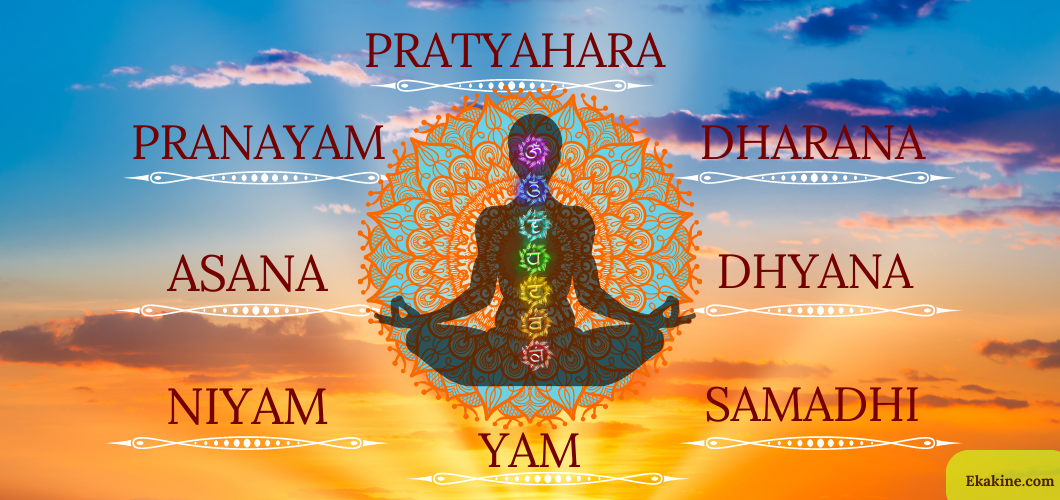What is Ashtanga Yoga/Raj Yoga - A Complete Guide.
Friends it’s important to talk about the source of information posted in this blog, so that you can be rest assured that the every bit of information shared in this blog is reliable and trustworthy; if you may find it so. All that we share here is majorly out of my experiences that I have gained at different stages of my life. Let us now get straight to the subject – What is Ashtanga Yoga? Well, before we dive deep into this subject, please know that Ashtanga Yoga is also known as Raj Yoga or Royal Yoga. It is my sincere request that please do not read this article thinking that Ashtanga Yoga is only for Hindu’s or any particular religion because our aim is to share the knowledge and if it benefits you then we will be the happiest. What we are sharing in this blog-post is about the development of the mind by cultivating inner awareness and self-control.
Would you agree that we do not have any right to say that we have a soul, if we do not feel it, or let’s say, there is no God if we does not see him? It’s my personal perception that if God exist then we must see him, if there is a soul in our body we must perceive it; otherwise it is better not to believe on any of these. Everyone wants to know the truth, people want to experience truth for themselves, grasp it to realize it and to feel it within their heart of hearts. The Ashtanga Yoga is a science and it talks about a practical and scientifically worked-out method of reaching this truth.
Ashtanga Yoga is an ancient spiritual system that originated in India many years ago. At this point try to understand two things: “Jivatman” and “Paramatman”. The individual self is called “Jivatman” and the Universal self (God) is called the “Paramatman”. The aim of Ashtanga Yoga or Raj Yoga is to unite the Jivatman with Paramatman through meditation and certain other techniques.
In this blog post, I will talk in detail about the eight limbs of Ashtanga Yoga, its benefits, and how to practice it plus a few common misconceptions about this branch of Yoga. As the author of this blog, my object is to provide insights into the transformative power of Ashtanga Yoga and how it can help us achieve spiritual, physical, and mental well-being.
The Eight Limbs/Steps of Raj Yoga
When we say What is Ashtanga Yoga; what we are trying to learn is the truth. The learning of this branch of yoga starts with the description of the Eight Limbs or steps of Ashtanga Yoga or Raj Yoga. We have to understand how these eight limbs work together and how someone achieves the ultimate goal of self-realization. These eight limbs are basically a step-by-step guide that is explained in the Patanjali Yoga Sutras. For the benefit of those of you who do not know who is Patanjali; he was a great saint and a scientist who pointed out the possibilities of possessing occult powers, but at the same time he never missed an opportunity to warn mankind against these powers. There is no denying that knowledge is power, and the moment we begin to know a thing we seem to get power over it; similarly, when the mind begins to meditate on the different elements it gains power over them. What are these steps; its mentioned below:
- Yama – The first step is Yama which means no killings, no stealing, truthfulness, continence and no receiving any gifts.
- Niyama: This next step is all about our personal observances like contentment, cleanliness, study, mortification and surrender ourselves to God. Please note when I say surrender to God, I mean any God that people worship; whoever you like to follow; nothing specific to any religion.
- Asana: This means posture in simple terms. These are the physical postures or a series of exercises both physical and mental that needs to be done every day until certain higher states are reached. Asanas help to prepare our body and mind for meditation. The aim is to strengthen and purify the body, increase flexibility, and balance the flow of energy.
- Pranayama: This next one is all about controlling the vital forces of the body. These are the breathing techniques one must practice because these help in controlling the energy flow and also the mind.
- Pratyahara: This is about transforming our mind into an introspective mind. In a simpler sense, this means training the mind to detach itself from external distractions and focus on the inner self.
- Dharana: This is about concentration. Here we train and practice holding our minds on a single point. Dharana helps in attaining the ability to quiet the mind.
- Dhyana: This is about meditation. Here we practice sustained concentration on a particular concept or single object.
- Samadhi: This is the ultimate goal of Ashtanga Yoga; the attainment of super-consciousness. A state of complete absorption to form a union with the universal self. In the samadhi state, the practitioner experiences a profound sense of oneness.
The Yama and Niyama, are moral training and are thus the first two steps in Ashtanga Yoga or Raj Yoga. As the practitioner or the Yogi establishes these practices he/she will begin to realize the fruits of this practice; and without establishing these two steps there is no possibility to bear the fruit. In Ashtanga Yog we must remember that as a Yogi you should not think of hurting or injuring anyone through your thoughts, words, or deeds. This principle applies not just to man, but also to all animals. Mercy shall not be only for men alone, but it shall go beyond; and embrace the whole world.
Frequently Asked Questions – Ashtanga Yoga
- Yama – The first step is Yama which means no killings, no stealing, truthfulness, continence and no receiving any gifts.
- Niyama: This next step is all about our personal observances like contentment, cleanliness, study, mortification and surrender ourselves to God. Please note when I say surrender to God, I mean any God that people worship; whoever you like to follow; nothing specific to any religion.
- Asana: These are the physical postures or a series of exercises both physical and mental that needs to be done every day until certain higher states are reached. Asanas help to prepare our body and mind for meditation. The aim is to strengthen and purify the body, increase flexibility, and balance the flow of energy.
- Pranayama: This next one is all about controlling the vital forces of the body. These are the breathing techniques one must practice because these help in controlling the energy flow and also the mind.
- Pratyahara: This is about transforming our mind into an introspective mind. In a simpler sense, this means training the mind to detach itself from external distractions and focus on the inner self.
- Dharana: This is about concentration. Here we train and practice holding our minds on a single point. Dharana helps in attaining the ability to quiet the mind.
- Dhyana: This is about meditation. Here we practice sustained concentration on a particular concept or single object.
- Samadhi: This is the ultimate goal of Ashtanga Yoga; the attainment of super-consciousness. A state of complete absorption to form a union with the universal self. In the samadhi state, the practitioner experiences a profound sense of oneness.
- There are numerous benefits of practicing the Ashtang Yoya or Raj Yoga. One of the major benefits is that there will be no more nervous excitement; on the contrary, you will feel the calmness it brings to your life. The practice of this branch of yoga will dramatically improve the ability to see things more clearly.
- Regular practice of Ashtang Yoga asanas (the postures discussed above) can help in improving balance, flexibility stamina, and strength. Additionally, it can also help in reducing anxiety, stress, and tension and thereby lowering blood pressure, and improving overall cardiovascular health.
- Practicing Ashtanga Yoga, one can improve his/her memory, focus, and concentration, which in turn boosts creativity and productivity.
- The ultimate aim of Ashtanga Yoga is self-realization and the union of the individual self with the universal self. By practicing Ashtanga Yoga, one can develop a deeper understanding, of the inner self.
- It can serve as a medium to cultivate a sense of belongingness, connection, purpose, and meaning to something greater than oneself.
- Find a good and qualified teacher (guru): This is the first and most important step to mastering any form of yoga. Find a teacher who is qualified and one who can guide you through the practice of this branch of yoga. What you need is simple, easy-to-understand step-by-step guided assistance so that you develop slowly and safely.
- Start with the basics: The practice of Ashtanga Yoga begins with developing some ethical principles and personal discipline. First practice with the five “Yamas”: a) non-violence, b) truthfulness, c) non-stealing, d) celibacy or sexual restraint, e) and non-greed Once you have mastered the above areas go on mastering the five “Niyamas” a) purity b) contentment c) self-discipline d) self-study e) and surrender to the “Parmatma” or the universal self.
- Practice asanas: Next step would be to practice the Asanas, the physical postures that are needed to prepare the body and mind for meditation. A good idea would be to start with simple and easy postures and then gradually progress to more advanced postures. Focus on breath control and proper alignment. Here we need to understand that we have to hold our spinal column free and this can be attained by sitting straight and holding the neck, chest, and head in a straight line. The complete weight of the body will be supported by the ribs and that is how you can have a natural posture. Let the whole weight of the body be supported by the ribs, and then you have an easy natural posture, with the spine straight.
- Practice Pranayama: Next up is to practice Pranayama. What we did in the previous steps is purify the nerves because it gives the power to practice Pranayam. Ok, what is Pranayam? In layman’s words, it is the breathing technique. First, we block the right nostril with our thumb and then inhale air through the left nostril as per our capacity; then, without any interval, throw out the air through the right nostril while closing the left one. Start with this simple breathing exercise and gradually aim to progress to more advanced techniques.
Conclusion:
For faster progress, one needs to practice hard, and a strict diet is also absolutely necessary. When you are beginning to concentrate you will find that even the dropping of a pin will sound like a thunderbolt in your brain. The organs get finer and finer with everyday practice, and alongside you will notice that your perceptions get finer as well. These are the various stages through which one has to pass, and perseverance is the key to success. Give up all other distractions and argumentations, stay calm, and stay concentrated.




